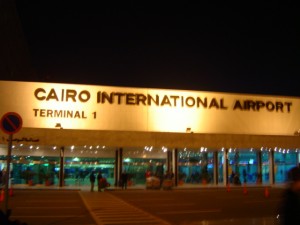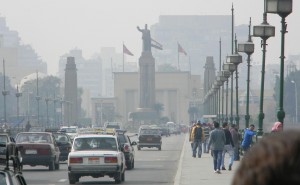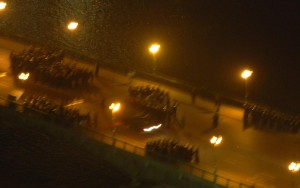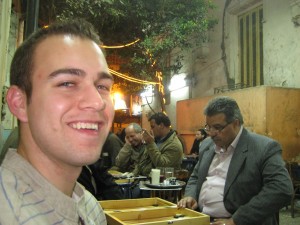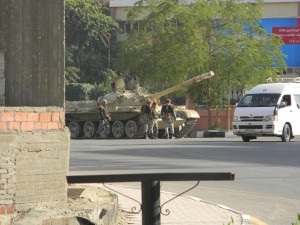
” RMC Professor on Ottawa’s First Chartered Rescue Flight …..”.
Ed Note: RMC professor, Dr. Yahia Antar was caught in the Egyptian fray last week. Following is his account of the experience.
By: Dr. Yahia Antar – Photo by: 24487 Dan Fleming
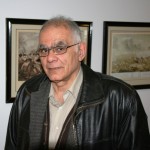 When you go for a conference, workshop or other academic duties you normally have your thoughts on many things other than what I have seen last week in Cairo, Egypt. I arrived in Cairo on Jan.25 which was the day the still ongoing protests in the streets started, with a military curfew in effect two days after. I could hear the sound of gun fire, see armored vehicles, and witness crowds of all sorts in the streets. Some were breaking the law and others were trying to enforce it, as there were no police present in the streets. Universities were closed and all businesses and meetings were canceled. Needless to say, the first thing one would think of is how to stay safe and away from harm, and the next thing is how to find a safe way out of this and back home. As it turned out this was not easy.
When you go for a conference, workshop or other academic duties you normally have your thoughts on many things other than what I have seen last week in Cairo, Egypt. I arrived in Cairo on Jan.25 which was the day the still ongoing protests in the streets started, with a military curfew in effect two days after. I could hear the sound of gun fire, see armored vehicles, and witness crowds of all sorts in the streets. Some were breaking the law and others were trying to enforce it, as there were no police present in the streets. Universities were closed and all businesses and meetings were canceled. Needless to say, the first thing one would think of is how to stay safe and away from harm, and the next thing is how to find a safe way out of this and back home. As it turned out this was not easy.
In the absence of Internet, cell phones, the only way of communication was land line telephones, but airlines do not answer calls, there was no way to check if flights are taking off or not. The only way was through phone calls with my wife back in Canada to try to get help from External Affairs.The Canadian Embassy in Cairo would not answer calls, or return my messages and my calls ended up being transferred to Canada, with only an answering machine in Ottawa : “Please leave a message.!” you can imagine how frustrating and disappointing it was to keep hearing that sound.
I had reservation to leave the country on Jan.31 early morning on a flight through Paris, so I decided to find a way out to the airport the day before during the period where a curfew was not in effect, and made it through the city . I could see tanks and other military vehicles all over the place and around the now famous Liberation or “Tahrir” Square as I passed by on the way..
At the airport, as expected, things were chaotic. All the foreigners were trying to leave, with many Nations trying to evacuate their nationals. No sign yet that Canadians have a way out. I learned that my scheduled flight was canceled with no other way out in sight. I saw two other Canadians wondering around the airport asking the same question: Is there a way out for us?
Airport photo from files prior to the current situation.
My wife told me that there were news about a Canadian evacuation plane, but I saw no signs of anything like that at the airport. After almost giving up I went back to camp at the hotel, there I met a fellow Canadian who told me the good news: the plane from Canada would be coming that afternoon to the rescue at terminal 3, and that we had to show up at the airport to look for it immediately.Three hours later, about 180 Canadians were gathered in empty space outside the airport’s terminal 1, around a big Maple Leaf placed on the grass so that others could see, and four officials from the embassy did the paper work needed to get us back.We were advised that we will have to sign a declaration to pay back the cost of this flight ($400), be flown to Germany and from there we have to find our way back to Canada. They escorted us through the chaotic airport and finally when we were about to leave, we ran into other complications as was heard on the news. At exactly 9:50pm, the Air Canada plane (flight 7003) took off on way to Frankfurt. One can imagine the feelings at that moment and the loud cheers by the crowd.
At Frankfurt, Air Canada and other Canadian officials were rather helpful, and they offered us reasonable arrangements and I booked a ticket to get on the next flight to Toronto in the morning of Feb.1. All of us waited at the airport that night trying to help each other. Arriving in Toronto I had a different feeling to it at that time. Indeed, it is comforting to be back home among family, colleagues,and friends. My thoughts and prayers go to those whom we witnessed die, and to those who are fighting for some of the things we have here and we always take for granted.
Eyewitness Account of the Crisis in Egypt
By 24174 2Lt Jean Le Bouthillier
Ed Note: 2Lt Jean Le Bouthillier is the former captain of the 2009 RMC Sandhurst Championship team.
Introduction
I recently travelled to Cairo, Egypt to represent RMC at the World Congress on Computer Science and Information Technology 2011. My stay in Egypt extended from the 22nd of January to the 1st of February and I had the opportunity to witness the start and evolution of the Egyptian crisis. It was an interesting experience; I had the opportunity to observe a relatively ordered society descend into a chaotic mess. In what follows, I present an account of the events I saw them unfold during my travels.
22nd to 24th of January 2011 – Arrival and beginning of the conference
I arrived in Cairo on the 22nd of January and checked-in at my hotel. I took advantage of the first day to walk around Cairo and to get a feel for the place. The overwhelming police presence and the chaotic flow of motorized traffic in the city were some of the major differences an unfamiliar Westerner would first notice in Cairo. I would describe the city itself as a crossroad between old and new where Western influences are intertwined with millennium old traditions. The city of Cairo is densely populated, its population is extremely religious and the city is littered with trash. After discussions with the locals, I learned that unemployment is rampant in the city and that most government employees will earn an average of 60$ a month. I began my Conference-related work on the 23rd and 24th of January at the Naval Forces House, on Zamalek Island, where I met several Egyptian scientists and engineers.
25th of January 2011 – National Police Day and beginning of the protests
Everything was normal in Cairo until the 25th of January at around 1500 hrs. The conference was on break when some Egyptians began to yell and point at the bridge linking Zamalek Island to Cairo. The scene was quite unusual as I could see a large crowd of approximately twenty-five thousand people chanting and walking towards central Cairo. I asked Dr. Mansour, an Egyptian participant in the conference, what was going on. He told me that: “today is the National Police Day and the protest organizers selected this day because they hope to secure police support during their very own holiday” and he added “the protesters are smart because they only started late in the afternoon, now all the policemen will be asleep and unprepared”. I inquired about the motivation for the protests and I was basically told that corruption, poverty and unemployment were the main reasons. In addition, I was told that most people saw the government of Hosni Mubarak as a corrupt regime which didn’t care about Egyptians. At the end of the day, I headed to my hotel and witnessed a large police contingent manoeuvring to close the bridge used by protesters earlier in the day. I could see large clouds of tear gas across the bridge; the police where making an extensive use of it to control the crowds. I initially decided not to take pictures fearing that my camera would be confiscated, but I later went on the hotel roof and photographed the events that were transpiring. I could also see and hear parts of the protest movement from the hotel roof and heard intermittent gunfire throughout the night. I had first thought that the government intentionally waited until dusk to crack down on the protesters, but later learned that most of the shots fired were warning shots and that only 4 deaths and a few injuries had occurred.
26th and 27th of January 2011 – A lull in the protests
Having watched the police manoeuvre in the city and block all key access points to Cairo during the night of the 25th, I was convinced that it would not be possible for protesters to sustain their activities. A lull in the protests enabled me to leave the hotel and visit the pyramids in Giza as well as the Cairo Museum, which is adjacent to Tahrir square. The police presence was heavy (in the thousands) throughout the city of Giza and Cairo. It seemed like the government had regained control over the population and that the situation was soon to return to normal.
However, I later went to a local “café” (the equivalent of a bar for Egyptian people as alcohol consumption is largely unpopular) where I had a tea and smoked “Shisha” with the locals. The locals explained that the 27th was the last day of exams for university students, which is why they could not participate in the protests. I was also told that, following completion of their academic session, they would most likely join the protests. The movement would walk on Cairo again on the 28th after noon prayer. When I told the locals that I was studying in the field of computer science, they expressed their thankfulness for the Western world bringing tools such as Facebook and Twitter to Egypt (tools which were heavily used to organize the demonstrations). Despite discussions with the locals, I remained sceptical about the possibility of a larger protest the next day. My assessment was based on the large number of police/riot forces present in the city. It seemed improbable that the protesters would breach Cairo again. I presented my paper on the 27th at the conference and it seemed that life remained unchanged in Cairo besides a slightly heavier police presence.
28th of January 2011 – Protests intensify and departure for Luxor
I woke up in Cairo the 28th of January and found myself without internet, which I used to place Skype phone calls in lieu of the expensive 4$ per minute calls by land line. It was uncertain to me whether or not the Egyptian government was responsible for the internet disruption. The same heavy police presence occupied the bridge between Zamalek and Cairo. That morning, I was leaving for Luxor where I knew the protests were relatively calmer; the situation in Cairo would no longer affect me. I arrived in Luxor at around 13h00 and immediately proceeded to visit the Karnak and Luxor temples on the East bank (the city of Luxor is divided by the Nile). Everything was normal at Karnak temple, but I found myself in the middle of sporadic protests on my way through the city towards the Luxor temple. The protesters used motorcycles, clubs and Molotov cocktails to raid different buildings. A bank was set on fire and other local stores were vandalised. I even got a taste of tear gas, which remained very low to the ground and was heavily used. Despite the protests I felt relatively safe because the protesters had no animosity towards the tourists. In fact, most Egyptians were very protective of tourists because tourism is the backbone of their economy.
29th and 30th of January 2011 – Luxor: The effects of the protests are felt
I visited the West bank of Luxor on the 29th and my trip was unaffected by the protests due to the relative remoteness of tourist attractions such as the Valley of the Kings and the Temple of Hatshepsut. I was, however, told that security had been increased in these locations for fear of looting. The effects of the protests were starting to be felt on the 30th as there was no internet connectivity, a shortage of fuel and no banking (all banks and ATM’s were closed). A rise in prices for food and transportation was felt in Luxor and tourists could not leave as trains, boats and airplane were not operating. It was reported that several prisons were deserted by the guards and that the escaped prisoners were on a looting spree. I spoke with other tourists who left Cairo after me and they reported that police forces had been disbanded and that the army assumed control of the city. I also learned that a curfew from 1500 hrs to 09h00 hrs was imposed and that this had the effect of disrupting most public services including transportation, refuelling and banking operations. Without internet, I had to find alternate ways of acquiring information. I purchased a newspaper which I used to get some news on the situation and to find the phone number of the Canadian Embassy in Cairo. My cell phone did not work in Luxor and I had a limited amount of cash so I began to limit my spending. I spent some cash for a calling card to contact the embassy. Despite several calls, I could never get through to the embassy so I assumed that they were probably overwhelmed. I tried to reach my parents in Canada, but I was not able to get through and decided to stop because the calls were outrageously expensive. On the night of the 30th, I witnessed something remarkable: the Egyptians self-organised check points and roaming patrols armed with old weapons and clubs to protect their own neighbourhoods and the tourists from escaped prisoners and rioters. I stayed on the West bank that night and heard several gun shots which I later learned were from the locals testing out old weapons that they had unearthed from their cache. I knew that planes were not leaving Luxor, but I decided to investigate the airport the next day. I organized transportation with a local guide and went to sleep.
31st of January 2011 – From Luxor to Cairo
I woke up in Luxor with around 2000 Egyptians pounds (around 300$) in my pocket and travelled to the airport. Upon arrival, I noticed that the area was heavily guarded by the Egyptian military and, therefore, quite safe. The airport was packed and many people had slept there hoping to catch a flight to Cairo. I stayed there with the guide who had organized transportation and found him to be very loyal and determined to help me get out of the airport. He went through the crowd and behind the airliner’s desk to get some up-to-date information. He came back and told me that nothing was flying out, but that I should wait as there was a rumour that flights might resume later in the day. I waited for a couple of hours and made some friends who were also headed back to Canada. Suddenly, a man came out of nowhere and claimed that he could charter a private plane to fly to Cairo. A panic ensued and people rushed towards him to get out of Luxor. Everything was very confusing and unfolding in Arabic so it took me a while to understand what was happening. I then spoke with my guide and asked him to get me the details. He told me that the flight was 200$ cash and they would leave in 4 hours. I told him that I had to get onto that flight, gave him my passport and the cash. He wasn’t afraid to push and yell so he made his way to the front and secured a place for me on the flight. I don’t think I have ever seen a scene where selfishness and lack of civic behaviour was more prevalent. People were pushing each other and moving as close as they could. I videoed the chaos as the crowd tried to get onto the flight. As I was filming the scene, a woman in tears approached me and begged me to stop filming this shameful display as she said that this was embarrassing for Egypt and that the world didn’t have to see it. I agreed and stopped filming. My guide came back with a ticket and I thanked him for his help. I was able to leave Luxor. I landed in Cairo around 1900 hrs where the airport was crowded with foreigners trying to leave the country. My plan was to meet with Canadian officials and get the latest on the situation. I only found one Canadian official who told me that the Canadian government had arranged for one evacuation flight per day and that I had already missed it. I told him that I had a scheduled flight the day after and he suggested that I should attempt to take this flight as half of the flights were still going out. After meeting with the Canadian official I confirmed my flight number and status with EgyptAir and accompanied an American friend on his journey to Hall 4 (the Americans were stationed at Hall 4 and were flying 6 evacuations a day). We had the hardest time finding Hall 4 and some local even tried to extort 200 pounds for a 5 minute cab ride from us. We offered him 4 pounds (the appropriate price) and got into an argument as he had already loaded our bags in his vehicle. We got our bags back and eventually made it to Hall 4 and I was impressed by the American response to the crisis. They had numerous staff working with triage stations and information boards. The Americans told us that flights would resume the next day. Despite the curfew, my American friend and I were able to leave the airport and stay at a local hotel.
1st of February 2011 – Leaving Egypt
I arrived at the airport for a scheduled departure of 0930 hrs. However, the airport was overcrowded with people who had spent the night there and no one could go pass security so we were all stuck in the “lobby” area of the airport. Slowly, flights became available and people proceeded through security. When the first flight was announced, people thought that security was letting everyone through so a lot of people were pushing to get to the front. I even had people ask me to stop being civilized and to push forward. Of course I politely told them that this would not solve anything. Various scenes of violence and despair ensued, but the majority of the people were civilized and waited in an orderly fashion. After waiting the whole day, my flight was finally announced and I left at around 1700 hrs. I then made it to Heathrow, UK where I was able to phone and report my whereabouts. The next day I flew to Canada.
Conclusion
From an academic standpoint, I was able to make interesting exchanges at the conference I attended, but this trip was much more for me. I spent an interesting time in Egypt where I was able to visit some of the most beautiful and significant locations of the antique world. Finally, I witnessed the beginning of an unusual and defining moment for the Egyptian people. I saw the failure of a system ripe with corruption; I drank tea with the locals and listened to their stories. I saw the uprising and the regime’s response. I witnessed first-hand the ensuing disorder and confusion and I now have a renewed appreciation for the civilized world.


